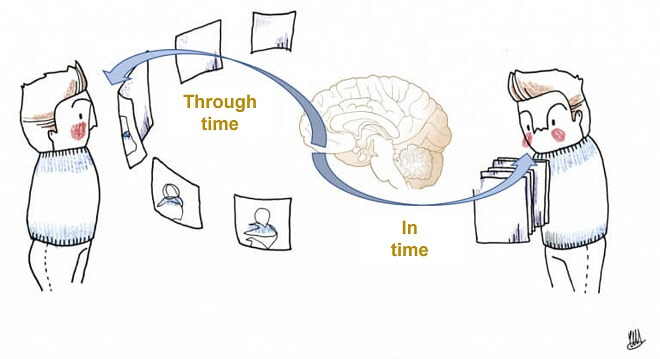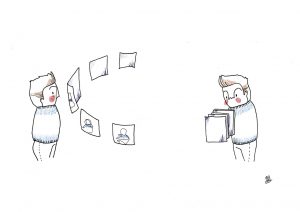We will continue to deepen on how the brain structures the time line. In the previous post we dealt with the time line in NLP. That is, how we connect present, past (memory) and future (imagination). Now we will raise the neuroscience of how the brain structures this time line. What happens in the brain in the two most frequent types of time line? We will also see how to take advantage of the two types of brain structure of time line: ‘through time’ and ‘in time’.
First, it is important that we are clear about what with the brain structure of time line, or the time line in the brain, we are referring to how our mind organizes the events of the past (memory), present and future (imagination).
On the other hand, we know that our brain does not distinguish between what it perceives directly from what it remembers or imagines. This is because the brain substrates of perception in the present, memory and imagination are the same.
But, each human brain organizes time in a different way. Generally based on the two fundamental types of time line, or brain structure of time, of which we spoke in the previous article; The NLP Time line (Neuroscience and NLP series – 1)
Now let’s continue reviewing the questions posed at the end of this article.
What typology is better regarding the perception and brain structure of time line? ‘Through time’ or ‘in time’? Is it worth changing?
Let’s start by remembering that from NeuroQuotient® we are dealing with the brain foundations of behavior (neurobehaviours) and the results that derive from it.
From our point of view no one is better or worse. That is why we avoid talking about personality. We only value if neurobehaviours give us better or worse results to each one. If they help to our satisfaction. When the results (satisfaction) are good we call them efficiencies and limitations when they can be improved.
Each type of brain structure of time line gives us important efficiencies. We saw it in the previous article. However, sometimes, they may be associated with some limitation. In these cases, it is worth taking conscience of it!
What efficiencies does each type of perception and brain structure of time line give us?
For example, the person with a tendency ‘through time’ will have a facility for all the efficacies related to prudence (See: Prudence, Strenghts and opportunities to improve)
This is because, in this case, our mind can take into account at the same time, many events placed in different moments in the time line. With that we can better perceive the cause-effect relationships between them.
The problem will appear when we want to prepare ourselves to face future dangers to which we give an exaggerated weight. If we worry too much, we can start, without any need, the system of threat (or fear) and the stress. Our mind does not distinguish between the lion that we have in front of the ‘lion’ that we can imagine.
Also, we can limit ourselves, when we get stuck around past events that we have perceived as unpleasant episodes.
The limiting neurobehaviours associated with the perception or time line ‘through time’ in the brain, can be summarized as: excessive focus on negative, connecting the present to the future or to the past.
On the other hand, brain perception and structure ‘in time’ facilitates the focus on the present and the creative thinking. The possible limitation in this case could be related, for example, to our mind jumping so fast from one thought to another, making it difficult our concentration.
Also, with a ‘through time’ structure in the brain, it may be difficult for us to perceive cause-effect relationships. In this way, learning problems can appear, such as the difficulty of learning from mistakes.
How can we explain the brain fundamentals for the two types of perception and brain structure of time line, from NeuroQuotient? Relationship between neuroscience and NLP
We believe that, likely, they have to do with differences in mesocortical dopamine. The one that comes from neurons in the ventral tegmental area, in mesencephalon, and is released in synapses of the prefrontal cortex.
This dopamine, when it works optimally, favors focusing and concentration. This happens when it has an adequate level, neither too little nor too much, and it is of the phasic type. The phasic dopamine is released as a result of connections and specific neuronal firings.
With the optimal functioning of mesocortical dopamine our thinking works like a laser. We do not have problems of dispersion or lack of attention. We discussed it in another post in which we treat attention deficit disorder (ADD)
This optimal dopamine is probably related to many of the prefrontal functions such as: working memory, impulse regulation, reality checking, error monitoring, etc.
‘Through time’ helps us causally connect past, present and future. With the perception ‘In time’ we easily connect ideas of the present.
The brain structure of time ‘through’, would be related to this optimal phasic mesocortical dopamine. It would make it easier to maintain several events at the same time and connect them causally with each other.
It would also help to avoid mistakes (by learning from past experiences) and to stop expectations that are not very consistent (by projecting learning towards the future).
When the brain is organized with a line ‘in time’ it is likely that the dopamine currents are not so directed (tonic release). This can lead to rapid change of focus, almost simultaneous, and to a greater facility to connect diverse ideas of the moment.
Limiting Neuro behaviours in this case, would have to do with what are strengths of the brain structure of time line ‘through’. That is, with the difficulty of concentration and connecting the causal relationships past, present, future.
It is very likely, too, that the speed of brain processing ‘in time’ is higher.
Spontaneous decision making, based on the intuition of the moment, may be related to this type of brain structure of time line ‘in time’. Although sometimes it can be perceived as impulsivity, it is a very effective neurobehaviour if the results are satisfactory for the person.
It is possible to improve the results? Yes, joining the efficiencies of both cerebral perceptions of time and minimizing limitations. Two strategies to do it.
Brain structure ‘Through time’ would measure the ability to learn with cause-effect relationships and to maintain different temporal experiences at the same level in the working memory. The brain organization ‘In time’ would give us the measure of a great speed of brain processing. By joining the efficiencies of both and minimizing their limitations we will have the highest prefrontal capacity.
Whatever our type of perception of time in the brain, the first step is to become aware that it is worthwhile to improve our results.
From there, it is convenient to design a new behavior. Then, with its repetition we create and consolidate new brain connections (neuro behaviours) from which better results will be derived.
How to do it, specifically? How to design a new neuro behaviour?
Briefly. If we have a brain structure ‘in time’, it is convenient to work on the capacity for concentration (effectiveness of the ‘through’ brain structure of time line) and, also, in connecting the experiences over time.

In our projects, for example, we can put before us drawings (in post-its) that help us appreciate the connection between our past (memories), present and future (imagination). Where we come from, where we are and where we want to go.
What to do when our time organization in the brain is ‘through’? In this case, it is key that we learn to break the loops of worry (negative focus towards the future) or rumination (negative approach to the past).
One possible strategy is to teach the brain to jump from one thing to another. But, always with positive and optimistic focus! We can play with images that awaken our reward system and to move our attention from one to the other, randomly.



